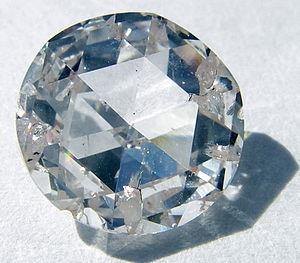
A rose-cut synthetic diamond created by Apollo Diamond using a patented chemical vapour deposition process. (Photo credit: Wikipedia)
Sometimes when you are looking at a diamond the light can blind you. Both literally and figuratively. In fact, when you are buying a diamond, I believe that one of the most important things you should look at isn’t the cut of the diamond or even the dimensions, but the sparkle and dispersion. Or, if the light blinds you or not.
Rick Pucko, who is a colored gemstone guy from LinkedIn asked me this question from a thread that I started about an article addressing the lack of sparkle on a Cushion cut,
What cut(s) give emphasis on color dispersion over sparkle?
Dispersion Vs. Sparkle
First, you have to understand the difference between what dispersion and sparkle are.
Dispersion is the flashes of color that are commonly called fire, which is the separation of white light into all it’s colors of red, orange, yellow, green, blue and violet. The sparkle is also called scintillation. This happens when the diamond catches the light around it and it sparkles with flashes of white and spectral colored light. So, dispersion is the separation of the colors within the diamond and the sparkle is where you see those colors within the stone when the diamond catches the light.
Emphasis on Dispersion Over Sparkle
Because a slightly taller crown and smaller table generally causes dispersion, this is best seen in daylight where all light spectrums are present to begin with, or in jewelry stores with powerful lighting. Since the lighting in which you examine the diamond is so critical to its dispersion, it would be very difficult to evaluate this trait when going from store to store.
I find that well cut European cuts (those with tall rather than shallow crowns) have a lot of dispersion. Really well cut round stones with very small (54-57%) tables also have a lot of dispersion. Generally step cut (emerald cut) diamonds seem to exhibit the least amount of dispersion.
Comparison Shopping
If I were trying to comparison shop based on dispersion, I would probably buy a pocket penlight with a warm (yellowish) bulb for a few bucks and take it with me from store to store. Rotate the diamond (or the penlight) to see the prism colors. The diamond that speaks to you in color the most would be the diamond that has the most dispersion and if you are going to buy on that alone, then that would be the diamond for you.
